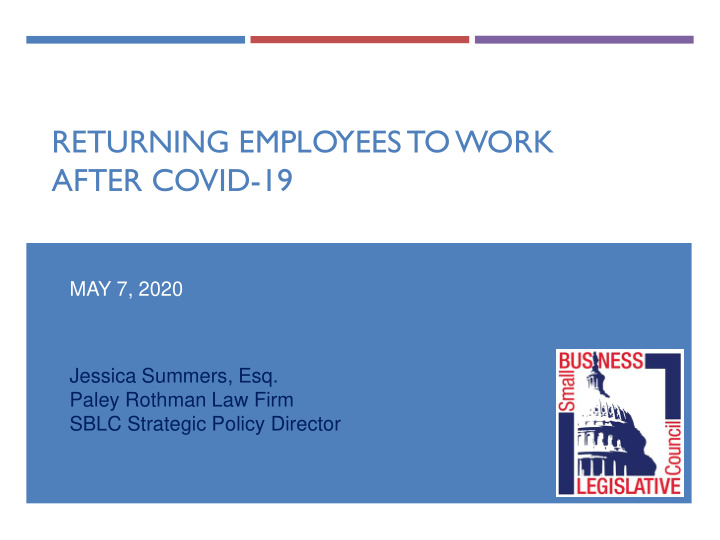



RETURNING EMPLOYEES TO WORK AFTER COVID-19 MAY 7, 2020 Jessica Summers, Esq. Paley Rothman Law Firm SBLC Strategic Policy Director
2 THE BASICS Plan and prepare Implement written policies Communicate Monitor Adapt
3 CRITICAL PLANNING QUESTION #1 When do we start bringing employees back into the workplace?
4 RETURN TO THE WORKPLACE – FACTORS TO CONSIDER State and local law and guidance Capacity of some or all employees to telework Physical limitations of the workplace Availability of employees Options for phased return OSHA Guidance 3990
5 CRITICAL PLANNING QUESTION #2 What modifications can be made to the physical structure and maintenance of the workplace to prevent the spread of COVID-19?
6 STRUCTURE AND MAINTENANCE – FACTORS TO CONSIDER De-densifying to facilitate social distancing Cleaning practice Creating employee zones One way hallways Limiting or closing off communal spaces (kitchens, conference rooms, etc.) Ingress and egress (doors, elevators, etc.)
7 CRITICAL PLANNING QUESTION # 3 What type of PPE or other special equipment/products will be required or utilized to prevent the spread of COVID-19?
8 PPE/EQUIPMENT – FACTORS TO CONSIDER Masks or face covering (type? required?) Gloves (required?) Hand sanitizer, wipes and other cleaning supplies (availability?) Who will be responsible for providing? What about customers, vendors or other visitors?
9 CRITICAL PLANNING QUESTION #4 What other modifications can be made to the way we conduct business to prevent the spread of COVID-19?
10 OTHER MODIFICATIONS – FACTORS TO CONSIDER Employee shifts and overlap Greetings Site visits and travel Customers, vendors and visitors to the workplace
11 CRITICAL PLANNING QUESTION #5 How will we identify and address potential risk areas?
12 IDENTIFYING RISK - FACTORS TO CONSIDER Employee self-checks Employee testing Employee self-reporting requirements Visitor screening
13 CRITICAL PLANNING QUESTION #6 How will we respond if an employee tests positive for COVID- 19, is exhibiting symptoms of COVID-19 or has been exposed to COVID-19?
14 RETURN TO THE WORKPLACE – FACTORS TO CONSIDER Quarantine Leave Notice to other employees/ contact tracing HIPAA privacy issues Return to work certifications
15 CRITICAL PLANNING QUESTION #7 How will we implement and enforce any new measures?
16 ENFORCEMENT – FACTORS TO CONSIDER Pre-return communications Updating written policies Manager/supervisor oversight Employee reporting system Notice of consequences
17 HANDLING EMPLOYEES WHO DON’T WANT TO RETURN TO WORK Identify the reason Assess any accommodation obligations or leave rights Communicate with the employee
18 REASONS WHY EMPLOYEES MAY NOT WANT TO RETURN Employee is at high risk for severe COVID-19 Employee lives with someone who is high risk Employee is making more on unemployment than employee would working Employee is caring for child(ren) Employee is not high risk but is scared about catching COVID-19 Employee’s job duties and/or compensation has changed
19 REASONABLE ACCOMMODATION IN THE AGE OF COVID-19 Under the ADA (and state/local equivalents), an employer must provide a reasonable accommodation to an employee with a disability unless doing so would pose an undue hardship on the employer A reasonable accommodation may include allowing the employee to telecommute, work on a reduced schedule or take leave Mental health issues may qualify as a covered disability
20 LEAVE IN THE AGE OF COVID-19 FMLA (50 or more employees) FFCRA Emergency FMLA (any size) FFCRA Paid Sick Leave State or Local Paid Sick Leave
21 COMPENSATION AND BENEFITS ISSUES Businesses bringing employees back to work should assess: Exempt v. non-exempt classifications Wage and hour issues Benefits eligibility Contractual obligations
22 OTHER TRICKY ISSUES TO CONSIDER AND PLAN FOR Employees who typically take mass transit to work Impact of business decisions (such as terminations) on PPP loan forgiveness eligibility Business liability Discrimination claims Image and reputation
23 QUESTIONS? Thank you for joining us!
Recommend
More recommend